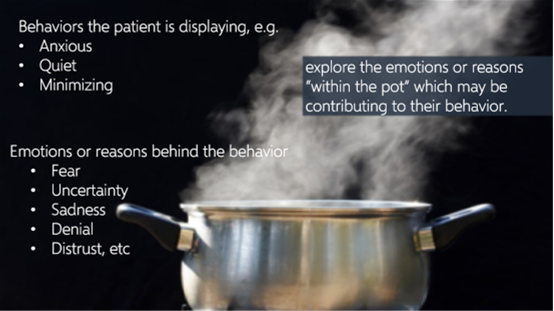Delivering Serious News
Serious news can be defined as any news that may change someone’s sense of their future. In this chapter and in our workshop, you’ll learn how to share serious news in a supportive, straightforward and empathetic way, to make a difficult situation somewhat easier. To start on our journey, let’s hear from Pam, a Seattle speech and language pathologist who volunteered to share her story.
Pam deeply appreciated the empathetic, supportive, and straightforward way that her physician shared information. As you think about delivering serious news yourself, you may feel uncomfortable or scared, but the techniques introduced here will help you feel more prepared. Although the circumstances may still be sad or upsetting, when we have the tools to communicate with empathy these moments can be rewarding and create deep connection between you and your patients.
Giving bad news is a common task for providers, but never one that is easy. Dr. Tony Back is an internationally recognized expert on palliative care and he’ll be guiding us today through how to deliver serious news.
Why delivering serious news well matters
We all start medical training with different degrees of comfort in our ability to communicate with others. No matter where you start from, you can always improve through practice and feedback. Let’s hear why this particular skill set is so important.
When we are able to deliver serious news well we develop trust and provide patients with the information and opportunity to make difficult decisions that are in line with their goals and values.
Student role in delivering serious news
As Foundations students, you’re working on your interviewing and physical exam skills. More senior clinicians will usually take responsibility for sharing life-limiting diagnoses and discussing prognosis, but you’ll have opportunities to share serious news earlier than you might think. As outlined by Dr. Back, any conversation has the potential to be perceived as serious or bad news. Using these communication skills across patient encounters will prepare you for the more serious conversations you will have in the future and recognizes that any news may be considered bad news for a particular individual.
Practice to Avoid Pitfalls
Just as there is a way to deliver serious news well, there is also the risk of doing it poorly – practice can help us to avoid common pitfalls.
GUIDE: a talking map
Emotions and serious news
When speaking with patients it is important to remember that there are two channels of communication that are occurring at all times. The emotional channel and the cognitive channel. It is important to make sure we are watching for emotions and responding to them first. Patients are often unable to access or process cognitive channels of information if their emotions are strong in the moment.
One of the first steps when recognizing emotion is to try to understand where that emotion may be coming from and what they may represent. We can think of emotions as data about what patients may be worried or concerned about. Use the analogy of a pot of boiling water. Think of the pot as being filled with more private or deeper emotions and the steam coming out of the pot as the more easily expressed or surface emotions and displayed behaviors. Instead of only responding to the surface emotions or behavior, consider exploring the deeper emotions within the pot which may be even more troubling to the patient. For example, the patient who appears sad or angry upon receiving serious news may actually be more worried or afraid of how this news may impact themselves, their family or loved ones. The NURSE or PEARLS framework which we discuss below can help you start to explore emotions more deeply and invite patients to share their greatest concerns.

Screen reader friendly version of the above graphic available here.
Responding to Emotion: Demonstrating Empathy
Dr. Back mentioned the NURSE framework for responding to and supporting your patients’ emotions. NURSE statements can be in any clinical encounter to demonstrate empathy, using words and phrases that feel natural for you.
PEARLS is another mnemonic for ways to demonstrate empathy – use the framework that feels more authentic and comfortable to you.
The following video first demonstrates a poor example of delivering serious news followed by a good example. The video is of a pediatric neurosurgeon telling the parents that their child has a brain tumor. While you are watching the first portion of the video where the news is delivery poorly you may be thinking that this could never happen. Unfortunately, you will see examples of serious news being delivered this way. It is most likely to happen when the news may not be perceived as gravely serious. It is important to remember, however, that what is considered serious differs for every patient. In order to not make assumptions about what is serious or not, consider using the GUIDE approach in most situations when sharing sensitive information.
Key skills in delivering serious news
- Give the patient and yourself uninterrupted time and attention. Reserve a quiet room for discussion, minimize distractions (such as pager or cell phone), sit down at eye-level at a socially appropriate distance from the patient and make sure there is a box of tissues handy in the room.
- Be sure to use clear, simple language to avoid confusion and misunderstandings. Adopt the patient’s language into your conversation when appropriate.
- Ask how much information the patient would like to have and if they want certain family members to be present for the conversation.
- Assess the patient’s understanding of their disease and correct any misunderstandings they may have.
- Prepare the patient that you are about to deliver bad news (e.g., “Unfortunately, I have some serious results to discuss with you.”). After delivering the serious news remember to pause for 10-15 seconds without talking to allow the patient to absorb the information.
- Allow the patient time and space to express emotion and resist the immediate temptation to describe how you plan to ‘fix it.’ (see above section on empathy).
- Repeat information as necessary or assess the patient’s understanding of the discussion before moving forward with treatment options.
Advice to medical students
Pam shares some poignant thoughts with medical students about working with patients with serious illness.
 Reflection
Reflection
Resources and references
American Family Physician. Delivering Bad or Life Altering News. This article provides other approaches to delivering serious news. The SPIKES approach closely resembles the GUIDE approach taught in this module. This article provides some specific language examples that could be used when delivering serious news.

